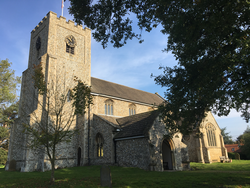
The Corpus of ROMANESQUE SCULPTURE in Britain & Ireland

Norfolk (now)
Parish church
Great Moulton is a vilage in Norfolk, located about 10 miles SSW of Norwich. The church of St Michael was rebuilt in 1887 but the Romanesque tower arch and imposts survive, as does the coursed flint masonry of the chancel and nave, bearing traces of round-headed windows. The fragment of a decorated colonnette is the only Romanesque sculpture observed at the site. It may have come from a window, as with the similar example in situ at St Mary Magdalene, just outside the centre of Cambridge.
Parish church
Fincham is a village in the King's Lynn and West Norfolk district, ten miles S of King's Lynn. The church stands in the village centre, and is an imposing mid-15thc building of flint and carstone with ashlar dressings, consisting of a 5-bay aisled nave with a S porch, a chancel and a 3-stage W tower. The only Romanesque feature is an early-12thc font, brought to St Martin's from the former church of St Michael, Fincham, a 12th and 13thc church demolished in the mid-18thc.
Parish church
St Mary's was built 1n 1866-8, following the design of the medieval building it replaced. It retains an elaborate Easter Sepulchre of c.1500 installed by the Townshend family of local and national significance. The spiral shafts described here constitute the only Romanesque sculpture at the site.
Parish church
Almost nothing earlier than its 13thc W tower is visible at St Edmund's, a striking building constructed of a combination of dark local carstone and even darker ferrugious conglomerate. In its present state, it dates from the 13th-15thc with much 19thc restoration in places. It has a chancel, an aisled nave and a N transept but there are also signs of a former S transept, indicating that the previous building on the site was cruciform. The small colonnette reset in a puropse-built recess in the external N wall of the N transept presumably came from an earlier church and is now the only Romanesque sculpture at St Edmund's.
Parish church
The W tower at St Andrew's was underway in 1431. Judging from the round-arched doorway preserved inside its E wall, the tower was attached to a nave that was Norman, at the latest, to which a N aisle had been added in the 13thc
Parish church
St Mary's was rebuilt in 1876, three years after the collapse of the tower, reusing old materials but also retaining some medieval fabric, including the S doorway and S transept. The only Romanesque carving at the church is on the pillar piscina in the chancel although this, too, is at least partly modern.
Parish church
Fishley lies to the east of Norwich, close to Acle. It was a substantial settlement in 1086. St Mary's is a small, largely 13thc church, with a round tower. The only Romanesque sculpture is on the (heavily restored) S doorway.
Parish church
The present building is a Grade II* Listed structure of 1859 designed by Robert Kerr which Pevsner notes was preceded by a medieval church with a round tower and double-splayed windows. The basin of the pillar piscina in the chancel is the only Romanesque sculpture at the site.
Parish church
All Saints comprises a chancel, nave, N aisle and polygonal W tower. The tower and chancel date from the 14thc and were restored in the mid-19thc. Both nave and chancel are thatched. All that can be easily detected of the early fabric of the church is the reset N doorway-which bears the building's only Romanesque sculpture-and the W wall of the nave.
Parish church
The present church, consisting of a chancel, nave, N aisle and a rectangular W tower the same width as the nave, is substantially 14thc in date and has an impressive hammerbeam roof. The font is the only feature with Romanesque sculpture.









